816 start with S start with S
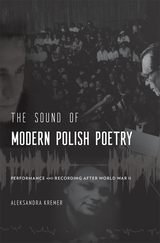
An illuminating new study of modern Polish verse in performance, offering a major reassessment of the roles of poets and poetry in twentieth-century Polish culture.
What’s in a voice? Why record oneself reading a poem that also exists on paper? In recent decades, scholars have sought to answer these questions, giving due credit to the art of poetry performance in the anglophone world. Now Aleksandra Kremer trains a sharp ear on modern Polish poetry, assessing the rising importance of authorial sound recordings during the tumultuous twentieth century in Eastern Europe.
Kremer traces the adoption by key Polish poets of performance practices intimately tied to new media. In Polish hands, tape recording became something different from what it had been in the West, shaped by its distinctive origins behind the Iron Curtain. The Sound of Modern Polish Poetry reconstructs the historical conditions, audio technologies, and personal motivations that informed poetic performances by such luminaries as Czesław Miłosz, Wisława Szymborska, Aleksander Wat, Zbigniew Herbert, Miron Białoszewski, Anna Swir, and Tadeusz Różewicz. Through performances both public and private, prepared and improvised, professional and amateur, these poets tested the possibilities of the physical voice and introduced new poetic practices, reading styles, and genres to the Polish literary scene. Recording became, for these artists, a means of announcing their ambiguous place between worlds.
Kremer’s is a work of criticism as well as recovery, deploying speech-analysis software to shed light on forgotten audio experiments—from poetic “sound postcards,” to unusual home performances, to the final testaments of writer-performers. Collectively, their voices reveal new aesthetics of poetry reading and novel concepts of the poetic self.


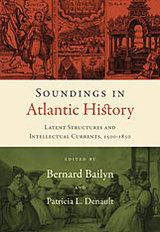
These innovative essays probe the underlying unities that bound the early modern Atlantic world into a regional whole and trace some of the intellectual currents that flowed through the lives of the people of the four continents. Drawn together in a comprehensive Introduction by Bernard Bailyn, the essays include analyses of the climate and ecology that underlay the slave trade, pan-Atlantic networks of religion and of commerce, legal and illegal, inter-ethnic collaboration in the development of tropical medicine, science as a product of imperial relations, the Protestant international that linked Boston and pietist Germany, and the awareness and meaning of the Atlantic world in the mind of that preeminent intellectual and percipient observer, David Hume.
In his Introduction, Bailyn explains that the Atlantic world was never self-enclosed or isolated from the rest of the globe but suggests that experiences in the early modern Atlantic region were distinctive in ways that shaped the course of world history.

The two main aims of this book are to increase the general availability of classical contributions to animal biology and to present the development of thought in this field in the words of those who produced it.
The first of these aims is realized by assembling in one volume works previously scattered and, in some cases, rather rare.
The second object, that of tracing the principal patterns of development in the field, is made possible through the selection of appropriate materials and the inclusion of brief critical comments indicating the historical position of each work and its author.

The phenomenal growth of modern astronomy, including the invention of the coronagraph and major developments in telescope design and photographic technique, is unparalleled in many centuries. Theories of relativity, the concept and measurement of the expanding universe, the location of sun and planets far from the center of the Milky Way, the exploration of the interiors of stars, the pulsation theory of Cepheid variation, and investigations of interstellar space have profoundly altered the astronomer's approach.
These fundamental discoveries are reported in papers by such eminent scientists as Albert Einstein, Sir Arthur S. Eddington, Henry Norris Russell, Sir James Jeans, Meghnad Saha, Otto Struve, Fred L. Whipple, Bernard Lyot, Jan H. Oort, and George Ellery Hale. The Source Book's 69 contributions represent all fields of astronomy. For example, there are reports on the equivalence of mass and energy (E = mc²) of the special theory of relativity; building the 200-inch Palomar telescope; the scattering of galaxies suggesting a rapidly expanding universe; stellar evolution; and the Big Bang and Steady State theories of the universe's origin.

When at the beginning of this century, new instrumentation in astronomy came together with innovative concepts in physics, a science was born that has yielded not only staggering quantities of information about the universe but an elegant and useful conception of its origins and behavior. This volume in Harvard’s distinguished series of Source Books serves to record the achievements of this science and illuminate its brief history by bringing together the major contributions through the year 1975.
The volume is organized to trace the development of the basic ideas of astrophysics. The 132 selections document chronologically the changing answers to such fundamental questions as: How did the solar system originate? What makes the stars shine? What lies in the vacuous space between the stars? Are the spiral nebulae distant “island universes”? Will the universe expand forever? The articles range from Hale’s popular piece in Harper’s Magazine to the tensor calculus of Schwarzschild and Einstein. They include Chamberlain and Moulton’s account of the collision hypothesis; Edwin Hubble’s identification of the Crab Nebula with the supernova of 1054; Ralph Fowler’s work on the application of degenerate gas statistics to white dwarfs; and Jan Oort’s detection of galactic rotation. The complexity and richness of twentieth-century astrophysics is felt in these selections and a sense of discovery is provided in reading, in the words of the pioneer scientist, accounts of the first observations of the cosmic rays, the Van Allen belts, the Martian volcanoes and canyons, pulsars, interstellar hydrogen, cosmic magnetic fields, quasars and the remnant background of the primeval big bang.
About half of the papers are printed in their entirety and the others in careful abridgment. Editors Kenneth Lang and Owen Gingerich provide substantial commentary that describes related developments before, during and after the selected research. Works by Heinrich Vogt, Carl Friedrich von Weizsacker, Karl Schwarzschild, Albert Einstein, Aleksandr Friedman and many others appear for the first time in translation.


The growing interdependence of the sciences was one of the outstanding characteristics of the first half of the twentieth century. "Inevitably," Dr. Leicester points out, "this expanded vision led to closer contacts among chemists of every speciality, and also with scientists in other fields. Physics and physical chemistry were applied to organic compounds, and new substances that could not have been foreseen by the older theories were prepared. Reaction mechanisms were generalized. New borderline sciences sprang up. Chemical physics and biochemistry became sciences in their own right. Chemistry thus became a link between physics and biology."
A continuation of A Source Book in Chemistry, 1400-1900 (HUP, 1952), this volume contains selections from ninety classic papers in all branches of chemistry -- papers upon which contemporary research and practices are based.
The topics include such chemical techniques as microanalysis, polarography, hydrogen ion concentration, chromatography, electrophoresis, and the use of the ultramicroscope, the ultracentrifuge, and radioactive tracers; modern structural theories, with emphasis on crystal structure, radioactive decay, isotopes, molecular structure, the applications of quantum mechanics to chemistry, thermodynamics, electrolytes, and kinetics; the more recent studies on artificial radioactivity and the transuranium elements; organic chemistry, with reference to general synthetic methods, polymers, the structure of proteins, nucleic acids, alkaloids, steroids, and carotenoids; and biochemistry, including the concept of hormones and vitamins, separation of enzymes and viruses, metabolism of fats, proteins and carbohydrates, and energy production.
The Source Book serves as an introduction to present-day chemistry and can also be used as supplementary reading in general chemistry courses, since, in many instances, the papers explain the circumstances under which a particular discovery was made--information that is customarily lacking in textbooks. Although the selections are classified into the usual branches of the science, it will be apparent to the reader how the discoveries in any one branch were taken up and incorporated into others.

An understanding of the developments in classical analysis during the nineteenth century is vital to a full appreciation of the history of twentieth-century mathematical thought. It was during the nineteenth century that the diverse mathematical formulae of the eighteenth century were systematized and the properties of functions of real and complex variables clearly distinguished; and it was then that the calculus matured into the rigorous discipline of today, becoming in the process a dominant influence on mathematics and mathematical physics.
This Source Book, a sequel to D. J. Struik’s Source Book in Mathematics, 1200–1800, draws together more than eighty selections from the writings of the most influential mathematicians of the period. Thirteen chapters, each with an introduction by the editor, highlight the major developments in mathematical thinking over the century. All material is in English, and great care has been taken to maintain a high standard of accuracy both in translation and in transcription. Of particular value to historians and philosophers of science, the Source Book should serve as a vital reference to anyone seeking to understand the roots of twentieth-century mathematical thought.

This remarkable volume presents a panorama of geographical writings from Hesiod to Humboldt, from the beginnings of geographical thought in the Western world to the emergence of topical specialization. It includes a wealth of material from non-Western sources, particularly Moslem and Chinese, that has not been collected before.
The selections are arranged chronologically, and contain geographical theory, descriptions of terrestrial phenomena by early observers, and excerpts from major voyages of discovery. Some are obvious classics: Socrates on the nature of the Earth, Ezekiel’s description of the commerce of Tyre, Columbus’s first glimpse of the West Indies, Buffon on the history of the Earth, and Kant’s geographical lectures. Yet more commonly, George Kish provides a sense of the discovery with such finds as the ambassador’s report to the Caliph of Baghdad on the lands and customs of the Norsemen, the study of the Tartar Empire by John of Monte Corvino, Archbishop of Peking, and Jefferson’s private memo to Alexander von Humboldt seeking information on the American West.
Each section is highlighted by a brief but engagingly written introduction by the editor. Throughout, the unique cultural and professional perspective of Kish is very much in evidence.


Since 1900, the science of geology has grown in a spectacular fashion. Not only have field studies been undertaken throughout vast areas of the earth’s surface previously unexplored or only superficially surveyed, but recent discoveries in physics, chemistry, and biology have provided geologists with new techniques of observation and experimentation, and radically new concepts and theories have been developed. This book presents source literature for the most important contributions to this remarkable expansion of geological knowledge. One of the world’s most distinguished geologists provides excerpts from sixty-five articles by sixty-three authors, selected with the advice of more than a score of leading scientists from all parts of the globe. Among the subjects discussed in this comprehensive volume are the constitution of the earth’s interior, the causes of earthquakes, radioactive timekeepers, the interpretation of submarine features and deep-sea cores, the origin and entrapment of petroleum, and crystal structure. Included are articles which led directly to the development of theories of paleomagnetism, metamorphism, cryopedology, and isostasy.
Source Book in Geology, 1900–1950 makes available several papers previously to be found in the libraries of only a few universities, and eight articles translated into English for the first time, of which four are by leading Soviet geologists.

Covering the general fields of mathematics, astronomy, mathematical geography, physics, chemistry and chemical technology, geology and meteorology, biology, medicine, and physiological psychology, the present collection surveys the field of Greek scientific achievement over a thousand-year period.
Many Greek scientific treatises were written and read by cultivated people who did not regard themselves as specialists. These works should appeal today to those readers who wish to understand not only the foundations of modern science, but also a vital element of the humanistic tradition.

The Source Book contains 75 excerpts from the writings of Western mathematics from the thirteenth to the end of the eighteenth century. The selection has been confined to pure mathematics or to those fields of applied mathematics that had a direct bearing on the development of pure mathematics.
The authors range from Al-Khwarizmi (a Latin translation of whose work was much used in Europe), Viète, and Oresme, to Newton, Euler, and Lagrange. The selections are grouped in chapters on arithmetic, algebra, geometry, and analysis. All the excerpts are translated into English. Some of the translations have been newly made by Mr. and Mrs. Struik; if a translation was already available it has been used, but in every such case it has been checked against the original and amended or corrected where it seemed necessary. The editor has taken considerable pains to put each selection in context by means of introductory comments and has explained obscure or doubtful points in footnote wherever necessary.
The Source Book should be particularly valuable to historians of science, but all who are concerned with the origins and growth of mathematics will find it interesting and useful.

Modern scholarship has exposed the intrinsic importance of medieval science and confirmed its role in preserving and transmitting Greek and Arabic achievements. This Source Book offers a rare opportunity to explore more than ten centuries of European scientific thought. In it are approximately 190 selections by about 85 authors, most of them from the Latin West. Nearly half of the selections appear here for the first time in any vernacular translation.
The readings, a number of them complete treatises, have been chosen to represent “science” in a medieval rather than a modern sense. Thus, insofar as they are relevant to medieval science, selections have been drawn from works on alchemy, astrology, logic, and theology. Most of the book, however, reflects medieval understanding of, and achievements in, the mathematical, physical, and biological sciences. Critical commentary and annotation accompany the selections. An appendix contains brief biographies of all authors.
This book will be an indispensable resource for students and scholars in the history of science.


This is a source book unique in its scope, clarity, and general interest. Its 116 excerpts range in time from Epicurus (ca. 300 B.C.) to the turn of the present century and sometimes, when continuity requires, a little beyond (as to K. S. Lashley, 1929). It includes excerpts from Kepler (1604) on the inverted retinal image, Descartes (1650) on the soul's interaction with the machine of the body, Newton (1675) on the seven colors of the spectrum, Locke (1700) on association of ideas, Whytt (1751) on the spinal reflex, Weber (1834) on Weber's law, Darwin (1859) on evolution, Sechenov (1863) on reflexology, Hughlings Jackson (1884) on nervous dissolution, William James (1890) on associationism, Thorndike, Pavlov, Wertheimer, Watson, and 70 other great figures in the history of psychology.
Arranged by topic rather than in the usual strict chronological order, each of the first fourteen chapters traces the development of one important subject in experimental and quantitative psychology. The final chapter discusses the history of thinking about the nature of psychology itself. The editors provide an introduction to each chapter and each excerpt, indicating the significance of the content to follow and establishing historical continuity.
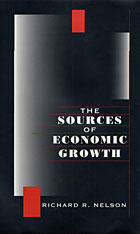
Technological advance is the key driving force behind economic growth, argues Richard Nelson. Investments in physical and human capital contribute to growth largely as handmaidens to technological advance. Technological advance needs to be understood as an evolutionary process, depending much more on ex post selection and learning than on ex ante calculation. That is why it proceeds much more rapidly under conditions of competition than under monopoly or oligopoly.
Nelson also argues that an adequate theory of economic growth must incorporate institutional change explicitly. Drawing on a deep knowledge of economic and technological history as well as the tools of economic analysis, Nelson exposes the intimate connections among government policies, science-based universities, and the growth of technology. He compares national innovation systems, and explores both the rise of the United States as the world’s premier technological power during the first two-thirds of the twentieth century and the diminishing of that lead as other countries have largely caught up.
Lucid, wide-ranging, and accessible, the book examines the secrets of economic growth and why the U.S. economy has been anemic since the early 1970s.
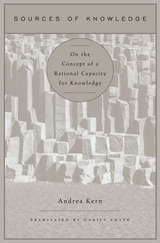
How can human beings, who are liable to error, possess knowledge? The skeptic finds this question impossible to answer. If we can err, then it seems the grounds on which we believe do not rule out that we are wrong. Most contemporary epistemologists agree with the skeptic that we can never believe on grounds that exclude error. Sources of Knowledge moves beyond this predicament by demonstrating that some major problems of contemporary philosophy have their roots in the lack of a metaphysical category that is fundamental to our self-understanding: the category of a rational capacity for knowledge.
Andrea Kern argues that we can disarm skeptical doubt by conceiving knowledge as an act of a rational capacity. This enables us to appreciate human fallibility without falling into skepticism, for it allows us to understand how we can form beliefs about the world on grounds that exclude error. Knowledge is a fundamental capacity of the human mind. Human beings, as such, are knowers. In this way, Sources of Knowledge seeks to understand knowledge from within our self-understanding as knowers. It develops a metaphysics of the human mind as existing through knowledge of itself, which knowledge—as the human being is finite—takes the form of a capacity.
Regaining the concept of a rational capacity for knowledge, Kern makes a powerful and original contribution to philosophy that reinvigorates the tradition of Aristotle and Kant—thinkers whose relevance for contemporary epistemology has yet to be fully appreciated.
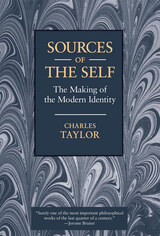
In this extensive inquiry into the sources of modern selfhood, Charles Taylor demonstrates just how rich and precious those resources are. The modern turn to subjectivity, with its attendant rejection of an objective order of reason, has led—it seems to many—to mere subjectivism at the mildest and to sheer nihilism at the worst. Many critics believe that the modern order has no moral backbone and has proved corrosive to all that might foster human good. Taylor rejects this view. He argues that, properly understood, our modern notion of the self provides a framework that more than compensates for the abandonment of substantive notions of rationality.
The major insight of Sources of the Self is that modern subjectivity, in all its epistemological, aesthetic, and political ramifications, has its roots in ideas of human good. After first arguing that contemporary philosophers have ignored how self and good connect, the author defines the modern identity by describing its genesis. His effort to uncover and map our moral sources leads to novel interpretations of most of the figures and movements in the modern tradition. Taylor shows that the modern turn inward is not disastrous but is in fact the result of our long efforts to define and reach the good. At the heart of this definition he finds what he calls the affirmation of ordinary life, a value which has decisively if not completely replaced an older conception of reason as connected to a hierarchy based on birth and wealth. In telling the story of a revolution whose proponents have been Augustine, Montaigne, Luther, and a host of others, Taylor’s goal is in part to make sure we do not lose sight of their goal and endanger all that has been achieved. Sources of the Self provides a decisive defense of the modern order and a sharp rebuff to its critics.


This book offers a systematic, comprehensive analysis of the rise and partial decline of racial segregation as an issue in southern electoral politics throughout the entire South over the third quarter of the twentieth century. The first comparative examination of a white political elite, the study draws upon an extraordinary breadth of data: 80 governorships, over 250 candidates, six “waves” of elections for each of the eleven southern states from 1950 to 1973.
By classifying candidates for the southern governorships according to their campaign stances on racial segregation, Earl Black maps out the changing racial attitudes of white office seekers over a critical period in southern history—the time now referred to as the Second Reconstruction. He shows that, largely because of Federal pressures, segregationist orientations have increasingly been replaced by nonsegregationist perspectives, and that the decline of segregationist rhetoric has been more evident in the peripheral south than in the deep south. Specific areas include: the segregation issue in the early 1950s; state-by-state summaries of the segregation issue after 1954; and the relationship between the candidates' campaign platform on race and their ability to run successfully at consecutive stages of the electoral process.
Black's conclusion that “stateways” can alter “folkways” is well-reasoned and persuasive. Accessible to all readers interested in public affairs, Southern Governors and Civil Rights makes a significant contribution to the literature on the consequences of national intervention to change southern racial attitudes.

Between 1880 and 1930, close to 200 women were murdered by lynch mobs in the American South. Many more were tarred and feathered, burned, whipped, or raped. In this brutal world of white supremacist politics and patriarchy, a world violently divided by race, gender, and class, black and white women defended themselves and challenged the male power brokers. Crystal Feimster breaks new ground in her story of the racial politics of the postbellum South by focusing on the volatile issue of sexual violence.
Pairing the lives of two Southern women—Ida B. Wells, who fearlessly branded lynching a white tool of political terror against southern blacks, and Rebecca Latimer Felton, who urged white men to prove their manhood by lynching black men accused of raping white women—Feimster makes visible the ways in which black and white women sought protection and political power in the New South. While Wells was black and Felton was white, both were journalists, temperance women, suffragists, and anti-rape activists. By placing their concerns at the center of southern politics, Feimster illuminates a critical and novel aspect of southern racial and sexual dynamics. Despite being on opposite sides of the lynching question, both Wells and Felton sought protection from sexual violence and political empowerment for women.
Southern Horrors provides a startling view into the Jim Crow South where the precarious and subordinate position of women linked black and white anti-rape activists together in fragile political alliances. It is a story that reveals how the complex drama of political power, race, and sex played out in the lives of Southern women.
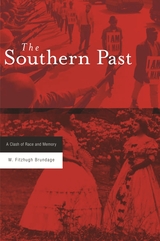
Since the Civil War whites and blacks have struggled over the meanings and uses of the Southern past. Indeed, today’s controversies over flying the Confederate flag, renaming schools and streets, and commemorating the Civil War and the civil rights movement are only the latest examples of this ongoing divisive contest over issues of regional identity and heritage. The Southern Past argues that these battles are ultimately about who has the power to determine what we remember of the past, and whether that remembrance will honor all Southerners or only select groups.
For more than a century after the Civil War, elite white Southerners systematically refined a version of the past that sanctioned their racial privilege and power. In the process, they filled public spaces with museums and monuments that made their version of the past sacrosanct. Yet, even as segregation and racial discrimination worsened, blacks contested the white version of Southern history and demanded inclusion. Streets became sites for elaborate commemorations of emancipation and schools became centers for the study of black history. This counter-memory surged forth, and became a potent inspiration for the civil rights movement and the black struggle to share a common Southern past rather than a divided one.
W. Fitzhugh Brundage’s searing exploration of how those who have the political power to represent the past simultaneously shape the present and determine the future is a valuable lesson as we confront our national past to meet the challenge of current realities.

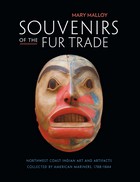
American mariners made more than 175 voyages to the Northwest Coast during the half-century after the ships Columbia and Washington pioneered the route from Boston in 1787. Although obtaining sea otter pelts for the China trade was the original purpose of the voyages, the art and culture of Northwest Coast Indians so intrigued and fascinated American sailors that the collecting of ethnographic artifacts became an important secondary trade. The Indians traded masks, hats, paddles, pipes, fishhooks, spoons, clothing, and canoe models from their canoes to the decks of Yankee vessels.
In this act of exchange, the artifacts moved from one world to another—first to shipboard, and later to the “cabinets of curiosities” of learned societies in Massachusetts, where many of them found homes. The objects were the first examples of Northwest Coast Indian material culture to enter American museums, and they influenced perceptions of Northwest Coast Indian people and their complex cultures.
By carefully researching the records of ten institutions and the shipboard journals of more than a dozen mariners, Mary Malloy has brought details about these early collections together for the first time. From utilitarian objects to artistic masterpieces, these souvenirs tell a story of commerce and cultural exchange that reached across the continent during the period when Americans were first beginning to look westward.
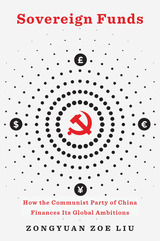
The first in-depth account of the sudden growth of China’s sovereign wealth funds and their transformative impact on global markets, domestic and multinational businesses, and international politics.
One of the keys to China’s global rise has been its strategy of deploying sovereign wealth on behalf of state power. Since President Xi Jinping took office in 2013, China has doubled down on financial statecraft, making shrewd investments with the sovereign funds it has built up by leveraging its foreign exchange reserves. Sovereign Funds tells the story of how the Communist Party of China (CPC) became a global financier of surpassing ambition.
Zongyuan Zoe Liu offers a comprehensive and up-to-date analysis of the evolution of China’s sovereign funds, including the China Investment Corporation, the State Administration of Foreign Exchange, and Central Huijin Investment. Liu shows how these institutions have become mechanisms not only for transforming low-reward foreign exchange reserves into investment capital but also for power projection. Sovereign funds are essential drivers of the national interest, shaping global markets, advancing the historic Belt and Road Initiative, and funneling state assets into strategic industries such as semiconductors, fintech, and artificial intelligence. In the era of President Xi, state-owned financial institutions have become gatekeepers of the Chinese economy. Political and personal relationships with prestigious sovereign funds have enabled Blackstone to flourish in China and have fueled the ascendance of private tech giants such as Alibaba, Ant Finance, and Didi.
As Liu makes clear, sovereign funds are not just for oil exporters. The CPC is a leader in both foreign exchange reserves investment and economic statecraft, using state capital to encourage domestic economic activity and create spheres of influence worldwide.
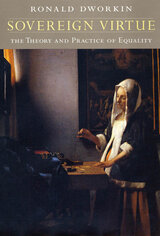
Equality is the endangered species of political ideals. Even left-of-center politicians reject equality as an ideal: government must combat poverty, they say, but need not strive that its citizens be equal in any dimension. In his new book Ronald Dworkin insists, to the contrary, that equality is the indispensable virtue of democratic sovereignty. A legitimate government must treat all its citizens as equals, that is, with equal respect and concern, and, since the economic distribution that any society achieves is mainly the consequence of its system of law and policy, that requirement imposes serious egalitarian constraints on that distribution.
What distribution of a nation's wealth is demanded by equal concern for all? Dworkin draws upon two fundamental humanist principles--first, it is of equal objective importance that all human lives flourish, and second, each person is responsible for defining and achieving the flourishing of his or her own life--to ground his well-known thesis that true equality means equality in the value of the resources that each person commands, not in the success he or she achieves. Equality, freedom, and individual responsibility are therefore not in conflict, but flow from and into one another as facets of the same humanist conception of life and politics. Since no abstract political theory can be understood except in the context of actual and complex political issues, Dworkin develops his thesis by applying it to heated contemporary controversies about the distribution of health care, unemployment benefits, campaign finance reform, affirmative action, assisted suicide, and genetic engineering.

How have conceptions and practices of sovereignty shaped how Chineseness is imagined? This ethnography addresses this question through the example of Macau, a southern Chinese city that was a Portuguese colony from the 1550s until 1999. As the Portuguese administration prepared to transfer Macau to Chinese control, it mounted a campaign to convince the city’s residents, 95 percent of whom identified as Chinese, that they possessed a “unique cultural identity” that made them different from other Chinese, and that resulted from the existence of a Portuguese state on Chinese soil.
This attempt sparked reflections on the meaning of Portuguese governance that challenged not only conventional definitions of sovereignty but also conventional notions of Chineseness as a subjectivity common to all Chinese people around the world. Various stories about sovereignty and Chineseness and their interrelationship were told in Macau in the 1990s. This book is about those stories and how they informed the lives of Macau residents in ways that allowed different relationships among sovereignty, subjectivity, and culture to become thinkable, while also providing a sense of why, at times, it may not be desirable to think them.

This is a study of the strategic challenges that Soviet ballistic missile defense (BMD) programs may pose for the Western alliance. David Yost suggests that the challenges for Western policy stem partly from Soviet military programs, Soviet arms control policies, and Soviet public diplomacy campaigns, and partly from the West’s own intra-alliance disagreements and lack of consensus about Western security requirements.
By reviewing the history of Western assessments of Soviet BMD, Yost shows that long before the American strategic defense initiative (SDI) was launched, Soviet BMD system modernization and infrastructure expansion were well under way, and that current Soviet programs are not mainly reactive to the SDI. Yost judges that the Soviets are probably better prepared than the Americans to deploy a network of traditional, ground-based BMD systems that would have at least some military value in the next decade, particularly against the limited and selective retaliatory attacks envisaged in NATO strategy. He does not argue that the Soviets are preparing for a clear-cut “breakout” from current arms control limits on BMD, but he notes the risks posed by activities that could eventually amount to a “creepout” from certain treaty constraints. Because of such ambiguities and the seriousness of the strategic and political stakes, the West should be prepared to pursue any necessary countermeasures in a timely fashion. His aim in this book is to advance understanding of the possible strategic challenges to the West and to identify potential points of consensus for Western policies.
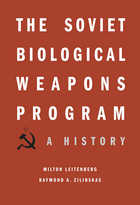
Russian officials claim today that the USSR never possessed an offensive biological weapons program. In fact, the Soviet government spent billions of rubles and hard currency to fund a hugely expensive weapons program that added nothing to the country’s security. This history is the first attempt to understand the broad scope of the USSR’s offensive biological weapons research—its inception in the 1920s, its growth between 1970 and 1990, and its possible remnants in present-day Russia. We learn that the U.S. and U.K. governments never obtained clear evidence of the program’s closure from 1990 to the present day, raising the critical question whether the means for waging biological warfare could be resurrected in Russia in the future.
Based on interviews with important Soviet scientists and managers, papers from the Soviet Central Committee, and U.S. and U.K. declassified documents, this book peels back layers of lies, to reveal how and why Soviet leaders decided to develop biological weapons, the scientific resources they dedicated to this task, and the multitude of research institutes that applied themselves to its fulfillment. We learn that Biopreparat, an ostensibly civilian organization, was established to manage a top secret program, code-named Ferment, whose objective was to apply genetic engineering to develop strains of pathogenic agents that had never existed in nature. Leitenberg and Zilinskas consider the performance of the U.S. intelligence community in discovering and assessing these activities, and they examine in detail the crucial years 1985 to 1992, when Mikhail Gorbachev’s attempts to put an end to the program were thwarted as they were under Yeltsin.
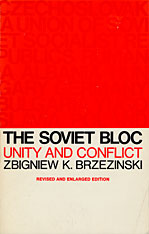
This is the first full-length study of relations among the communist states. The study explores the implications of the status of Yugoslavia and China, the significance of the Hungarian revolution and the position of Poland in the Soviet bloc, and clarifies the Khrushchev–Gomulka clash of 1956 and the complex role of Tito. Zbigniew Brzezinski emphasizes the role of ideology and power in the relations among the communist states, contrasting bloc relations and the unifying role of Soviet power under Stalin with the present situation. He suggests that conflicts of interest among the ruling elites will result either in ideological disputes or in weakening the central core of the ideology, leading to a gradual decline of unity among the Communist states.
The author, while on leave from his post as Professor and Director of the Research Institute on Communist Affairs, Columbia University, and serving on the U.S. State Department’s Policy Planning Council, has revised and updated his important study and added three new chapters on more recent developments. He gives particular attention to the Sino–Soviet dispute.

There is no better key to the strengths and weaknesses of the Soviet social system than Soviet law. Here in English translation is the Criminal Code and Code of Criminal Procedure of the largest of the fifteen Soviet Republics—containing the basic criminal law of the Soviet Union and virtually the entire criminal law applicable in Russia—and the Law on Court Organization. These two codes and the Law, which went into effect o January 1, 1961, are among the chief products of the Soviet law reform movement which began after Stalin’s death, and are a concrete reflection of the effort to establish legality and prevent a return to Stalinist arbitrariness and terror.
In a long introductory essay Harold Berman, a leading authority on Soviet law, stresses the extent to which the codes are expressed in authentic soviet legal language, based in part on the pre-Revolutionary Russian past but oriented to Soviet concepts, conditions, and policies. He outlines the historical background of the new codes, with a detailed listing of the major changes reflected in them, interprets their significance, places them within the system of Soviet law as a whole, and discusses some of the principal similarities and differences between Soviet criminal law and procedure and that of Western Europe and of the United States.



This is a study of Soviet policy in six West African countries: Ghana, Guinea, the Ivory Coast, Mali, Nigeria, and Senegal. Robert Legvold analyzes the awakening of Soviet Interest in sub-Saharan Africa and the growth, problems, and influences of the Soviet involvement from Ghana's independence in 1957 to 1968.
Those nations are significant not only because they were the first African colonies to achieve independence and therefore have had the longest involvement with the Soviet Union, but also because together they supply illustrations of every problem that Black Africa poses for an outside nation's foreign policy: from hypersensitive nationalism to what has been called neo-colonial dependence; from relative long-term stability to fundamental instability; from military coups d'état to civil war.
From the Soviet viewpoint the six countries range from the most progressive to the most reactionary. Each has had an interesting relationship with the Soviet Union.
The author considers several basic questions: How has the Soviet Union coped with the problems and opportunities created by Black Africa? How have its perceptions of Black Africa evolved during the first decade of its involvement there? Has policy shifted correspondingly with changes In these perceptions?Mr. Legvold explains why Black Africa lay largely ignored for years while Soviet leaders turned their attention to struggle and revolution in the Far East and South Asia. He has examined the Soviet and African press to trace the full evolution of Soviet attitudes and action in these countries, and has interviewed Soviet, African, and other officials. He compares Soviet policy as between one African nation and another, as well as between Africa and other continents.


As their woefully backward economy continues to crumble, much of the Soviet population remains indifferent, if not downright hostile, to the idea of reform. This phenomenon, so different from the Solidarity movement in Poland or the velvet revolution in Czechoslovakia, has been explained in terms of a “social contract”—a tacit agreement between the post-Stalin regime and the working class whereby the state provided economic and social security in return for the workers' political compliance. This book is the first critical assessment of the likelihood and implications of such a contract.
Linda Cook pursues the idea from Brezhnev's day to our own, and considers the constraining effect it may have had on Gorbachev's attempts to liberalize the Soviet economy. In case studies on job security, retail price stability, and social service subsidies, Cook identifies points at which leaders had to make critical decisions—to commit more resources or to abandon other policies at significant cost—in order to maintain the contract. The pattern that emerges attests to the validity of the social contract thesis for the Brezhnev period. At the same time, Cook's analysis points to several important factors, such as the uneven distribution of benefits, that help explain why labor unrest and activism have varied dramatically from sector to sector in recent years.
Ultimately, these case studies reveal, particularly for the Gorbachev period, deep conflicts between the old contract and the requisites of economic reform. Cook extends her analysis into the Yeltsin period to show how the democratizing state dealt weakly with labor's demands, seeking to stabilize labor relations with an inappropriate corporate structure. In the end, mobilized labor contributed greatly to the pressures that undermined Gorbachev's regime, and remained an obstacle to economic reform through the early months of Yeltsin's Russia.



The military achievements of the emperors Nikephoros Phokas, John Tzimiskes, and Basil II brought the Byzantine Empire to the height of its power by the early eleventh century. This volume presents new editions and translations of two military treatises—the Praecepta militaria of Nikephoros Phokas and the revised version included in the Taktika of Nikephoros Ouranos—outlining the tactical system used by Byzantine armies in campaigns against Muslim forces in Cilicia and Syria. Products of experienced soldiers, the texts offer a realistic view of Byzantine warfare and reveal the sophistication of Byzantine military science.
Eric McGeer places the treatises in military historical context; explores the factors that led the Byzantine army to fight as it did; and investigates morale, discipline, and leadership—all of which determined the difference between failure and success.



Space Commerce relates the story of private enterprise’s unsteady rise to prominence as a major influence on world space policy and research. The first space race proved the technological and military prowess of the two superpowers; but since the 1970s that contest has been supplanted by a multinational struggle to command the commercial opportunities of space.
The commercial space age was born in 1965 when Early Bird, the first commercial communications satellite, went into orbit. With characteristic ingenuity, American industrialists began to dream of garnering billions of dollars per year from space-based products and services. In the microgravity of space, they hoped, hitherto unavailable drugs could be produced that would revolutionize medicine; in the high vacuum of space, crystals of extreme purity could be grown in orbital laboratories, both for biological research and for application in the manufacture of advanced microcircuits.
John McLucas covers the broad sweep of space commerce, both the vision and the reality: the construction of communications satellites and their ground control stations; the sale and leasing of communications services; remote sensing and measurement of earth’s processes; navigation by satellites, serving ships, airplanes, and automobiles; the design and deployment of space laboratories for scientific research and product development; and life science experiments to determine the effects of space habitation on humans.
Drawing on his considerable expertise, McLucas brings a sober perspective to his assessment of the technological accomplishments as well as the challenges still faced by industry in space. He incorporates into his discussion an illuminating analysis of the economic and political impact of space commerce and its rapidly changing international character.


"This new edition ensures that the book will continue to be internationally acknowledged as the standard work on the development of modern architecture." -Walter Gropius
"A remarkable accomplishment. . . one of the most valuable reference books for students and professionals concerned with the reshaping of our environment. " -José Luis Sert
A milestone in modern thought, Space, Time and Architecture has been reissued many times since its first publication in 1941 and translated into half a dozen languages. In this revised edition of Sigfried Giedion’s classic work, major sections have been added and there are 81 new illustrations.
The chapters on leading contemporary architects have been greatly expanded. There is new material on the later development of Frank Lloyd Wright and the more recent buildings of Walter Gropius, particularly his American Embassy in Athens. In his discussion of Le Corbusier, Mr. Giedion provides detailed analyses of the Carpenter Center at Harvard University, Le Corbusier’s only building in the United States, and his Priory of La Tourette near Lyons. There is a section on his relations with his clients and an assessment of his influence on contemporary architecture, including a description of the Le Corbusier Center in Zurich (designed just before his death), which houses his works of art. The chapters on Mies van der Rohe and Alvar Aalto have been brought up to date with examples of their buildings in the sixties. There is an entirely new chapter on the Danish architect Jørn Utzon, whose work, as exemplified in his design for the Sydney Opera House, Mr. Giedion considers representative of post–World War II architectural concepts.
A new essay, “Changing Notions of the City,” traces the evolution of the structure of the city throughout history and examines current attempts to deal with urban growth, as shown in the work of such architects as José Luis Sert, Kenzo Tange, and Fumihiko Maki. Mr. Sert’s Peabody Terrace is discussed as an example of the interlocking of the collective and individual spheres. Finally, the conclusion has been enlarged to include a survey of the limits of the organic in architecture.
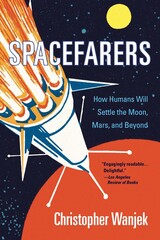
A Telegraph Best Science Book of the Year
“A witty yet in-depth exploration of the prospects for human habitation beyond Earth…Spacefarers is accessible, authoritative, and in the end, inspiring.”
—Richard Panek, author of The Trouble with Gravity
It’s been over fifty years since Apollo 11 landed on the moon. So why is there so little human presence in space? Will we ever reach Mars? And what will it take to become a multiplanet species? While many books have speculated on the possibility of living beyond the Earth, few have delved into the practical challenges.
A wry and compelling take on the who, how, and why of near-future colonies in space, Spacefarers introduces us to the engineers, scientists, planners, dreamers, and entrepreneurs who are striving right now to make life in space a reality. While private companies such as SpaceX are taking the lead and earning profits from human space activity, Christopher Wanjek is convinced this is only the beginning. From bone-whittling microgravity to eye-popping profits, the risks and rewards of space settlement have never been so close at hand. He predicts we will have hotels in low-earth orbit, mining and tourism on the Moon, and science bases on Mars—possibly followed (gravity permitting) by full blown settlements.
“Nerdily engaging (and often funny)…Technology and science fiction enthusiasts will find much here to delight them, as Wanjek goes into rich detail on rocketry and propulsion methods, including skyhooks and railguns to fling things into orbit…He is a sensible skeptic, yet also convinced that, in the long run, our destiny is among the stars.”
—The Guardian
“If the events of this year have had you daydreaming about abandoning the planet entirely, [Spacefarers] is a geekily pleasurable survey of the practicalities and challenges.”
—The Telegraph
“The best book I’ve read on space exploration since Isaac Asimov.”
—Michael Shermer, publisher of Skeptic

This book explores the trials of Spanish democracy from the death of Franco to the present. But the heart of the story is the generation that came of age in the 1960s, assumed political power, and formed the first Socialist government in 1982 with Felipe González as Prime Minister, which was returned to power in four consecutive elections. Starting in 1993, however, the government came under siege. High officials were accused of authorizing the assassination of as many as twenty-eight Basque nationalists suspected of terrorism over the years, and of covering up these crimes. This scandal, along with other disclosures of corruption and serious law-breaking, shook the country's confidence in its legal and political institutions and in its ability to hold its leaders to the rule of law.
The author probes for the roots of these events in the character of the generation that assumed power and in the immature nature of the civil society it inherited. Facing unusually high unemployment, internal economic and social pressures, the stringent requirements for joining the European Union, and the demands of Catalan and Basque nationalists, the government lost its way and was eventually voted out of office.
Using Spain as the example, the book examines issues of governance, social change, and internal nationalist movements as they relate to the civil society and the wider polity everywhere.


From the exhilarating impact of Isaac Albeniz at the beginning of the century to today's complex and adventurous avant-garde, this complete interpretive history introduces twentieth-century Spanish music to English-speaking readers. With graceful authority, Tomas Marco, award-winning composer, critic, and bright light of Spanish music since the 1960s, covers the entire spectrum of composers and their works: trends and movements, critical and popular reception, national institutions, influences from Europe and beyond, and the effect of such historic events as the Spanish Civil War and the death of Franco. Marco's penetrating aesthetic critiques are threaded throughout each phase of this rich account.
Marco provides detailed coverage of the key figures, induding a chapter devoted entirely to Manuel de Falla—Spain's most celebrated twentieth-century composer—and a panoramic survey of recent arrivals on the contemporary music scene. Exploring the rise and fall of the zarzuela, the author highlights innovative works in this authentic Spanish genre. He analyzes the attempts to find an audience for Spanish opera; demonstrates the flowering of symphonic and chamber music at the beginning of this century; traces currents such as romanticism, impressionism, and neoclassicism; and tracks the influence of Spain's distinctive regional folk traditions. Covering musical innovation after Spain's emergence from its period of isolation, Marco notes the speed with which many composers absorbed the work of Stravinsky and Bartok, the twelve-tone system, aleatory forms, electronic techniques, and other European developments.
English-speaking scholars, musicians, critics and general readers have for decades been without full information on the rich and varied work coming out of Spain in this century. This lively history fills a long-felt need and fills it superbly, with the knowledge and insights of a major figure in the musical world.
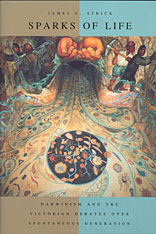
How, asks James E. Strick, could spontaneous generation--the idea that living things can suddenly arise from nonliving materials--come to take root for a time (even a brief one) in so thoroughly unsuitable a field as British natural theology? No less an authority than Aristotle claimed that cases of spontaneous generation were to be observed in nature, and the idea held sway for centuries. Beginning around the time of the Scientific Revolution, however, the doctrine was increasingly challenged; attempts to prove or disprove it led to important breakthroughs in experimental design and laboratory techniques, most notably sterilization methods, that became the cornerstones of modern microbiology and sped the ascendancy of the germ theory of disease.
The Victorian debates, Strick shows, were entwined with the public controversy over Darwin's theory of evolution. While other histories of the debates between 1860 and 1880 have focused largely on the experiments of John Tyndall, Henry Charlton Bastian, and others, Sparks of Life emphasizes previously understudied changes in the theories that underlay the debates. Strick argues that the disputes cannot be understood without full knowledge of the factional infighting among Darwinians themselves, as they struggled to create a socially and scientifically viable form of "Darwinian" science. He shows that even the terms of the debate, such as "biogenesis," usually but incorrectly attributed to Huxley, were intensely contested.
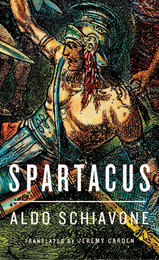
Spartacus (109?–71 BCE), the slave who rebelled against Rome, has been a source of endless fascination: the subject of myth-making in his own time, and of movie-making in ours. Hard facts about the man have always yielded to romanticized tales and mystifications. In this riveting, compact account, Aldo Schiavone rescues Spartacus from the murky regions of legend and brings him squarely into the arena of serious history.
Schiavone transports us to Italy in the first century BCE, where the pervasive institution of slavery dominates all aspects of Roman life. In this historic landscape, carefully reconstructed by the author, we encounter Spartacus, who is enslaved after deserting from the Roman army to avoid fighting against his native Thrace. Imprisoned in Capua and trained as a gladiator, he leads an uprising that will shake the empire to its foundations.
While the grandeur of the Spartacus story has always been apparent, its political significance has been less clear. What were his ambitions? Often depicted as the leader of a class rebellion that was fierce in intent but ragtag in makeup and organization, Spartacus emerges here in a very different light: the commander of an army whose aim was to incite Italy to revolt against Rome and to strike at the very heart of the imperial system. Surprising, persuasive, and highly original, Spartacus challenges the lore and illuminates the reality of a figure whose achievements, and whose ultimate defeat, are more extraordinary and moving than the fictions we make from them.
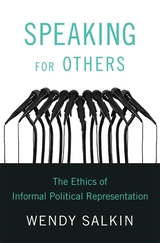
A political philosopher dissects the duties and dilemmas of the unelected spokesperson, from Martin Luther King, Jr., to Greta Thunberg.
Political representation is typically assumed to be the purview of formal institutions and elected officials. But many of the people who represent us are not senators or city councilors—think of Martin Luther King, Jr., or Malala Yousafzai or even a neighbor who speaks up at a school board meeting. Informal political representatives are in fact ubiquitous, often powerful, and some bear enormous responsibility. In Speaking for Others, political philosopher Wendy Salkin develops the first systematic conceptual and moral analysis of informal political representation.
Salkin argues that informal representation can be a political lifeline, particularly for oppressed and marginalized groups that are denied representation in formal political institutions. Yet informal political representatives exert outsized influence over the ways these groups’ interests are understood by the public, without the represented having much recourse to hold them accountable. And many informal political representatives are selected not by the groups they represent but by outsiders, sticking these groups with representatives they would not choose but cannot shake. The role of informal political representatives is therefore fraught with moral questions. What exactly are their duties and to whom are they owed? Should they be members of the groups they represent? When is informal representation permissible and when is it best avoided?
Informal political representation is taking place all around us. In fact, you yourself may be an informal political representative without knowing it. Speaking for Others explores the tensions central to this pervasive yet underexamined practice, bringing light to both its perils and its promise.

In the first half of the nineteenth century the Qing Empire faced a crisis. It was broadly perceived both inside and outside of government that the “prosperous age” of the eighteenth century was over. Bureaucratic corruption and malaise, population pressure and food shortages, ecological and infrastructural decay, domestic and frontier rebellion, adverse balances of trade, and, eventually, a previously inconceivable foreign threat from the West seemed to present hopelessly daunting challenges.
This study uses the literati reformer Bao Shichen as a prism to understand contemporary perceptions of and proposed solutions to this general crisis. Though Bao only briefly and inconsequentially served in office himself, he was widely recognized as an expert on each of these matters, and his advice was regularly sought by reform-minded administrators. From examination of his thought on bureaucratic and fiscal restructuring, agricultural improvement, the grain tribute administration, the salt monopoly, monetary policy, and foreign relations, Bao emerges as a consistent advocate of the hard-nosed pursuit of material “profit,” in the interests not only of the rural populace but also of the Chinese state and nation, anticipating the arguments of “self-strengthening” reformers later in the century.
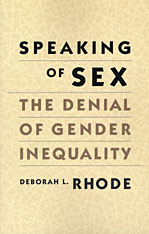
Speaking of Sex explores a topic that too often drops out of our discussions when we speak about sex: the persistent problem of sex-based inequality and the cultural forces that sustain it. On critical issues affecting women, most Americans deny either that gender inequality is a serious problem or that it is one that they have a personal or political responsibility to address. In tracing this “no problem” problem, Speaking of Sex examines the most fundamental causes of women’s disadvantages and the inadequacy of current public policy to combat them.
Although in the past quarter-century the United States has made major progress in addressing gender discrimination, women still face substantial obstacles in their private, public, and professional lives. On every significant measure of wealth, power, status, and security, women remain less advantaged than men. Deborah Rhode reveals the ways that the culture denies, discounts, or attempts to justify those inequalities. She shows that only by making inequality more visible can we devise an adequate strategy to confront it.
Speaking of Sex examines patterns of gender inequality across a wide array of social, legal, and public policy settings. Challenging conventional biological explanations for gender differences, Rhode explores the media images and childrearing practices that reinforce traditional gender stereotypes. On policies involving employment, divorce, custody, rape, pornography, domestic violence, sexual harassment, and reproductive choice, Speaking of Sex reveals how we continually overlook the gap between legal rights and daily experience. All too often, even Americans who condemn gender inequality in principle cannot see it in practice—in their own lives, homes, and work environments. In tracing these patterns, Rhode uncovers the deeply ingrained assumptions that obscure and perpetuate women’s disadvantages.
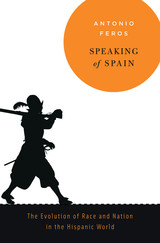
Momentous changes swept Spain in the fifteenth century. A royal marriage united Castile and Aragon, its two largest kingdoms. The last Muslim emirate on the Iberian Peninsula fell to Spanish Catholic armies. And conquests in the Americas were turning Spain into a great empire. Yet few in this period of flourishing Spanish power could define “Spain” concretely, or say with any confidence who were Spaniards and who were not. Speaking of Spain offers an analysis of the cultural and political forces that transformed Spain’s diverse peoples and polities into a unified nation.
Antonio Feros traces evolving ideas of Spanish nationhood and Spanishness in the discourses of educated elites, who debated whether the union of Spain’s kingdoms created a single fatherland (patria) or whether Spain remained a dynastic monarchy comprised of separate nations. If a unified Spain was emerging, was it a pluralistic nation, or did “Spain” represent the imposition of the dominant Castilian culture over the rest? The presence of large communities of individuals with Muslim and Jewish ancestors and the colonization of the New World brought issues of race to the fore as well. A nascent civic concept of Spanish identity clashed with a racialist understanding that Spaniards were necessarily of pure blood and “white,” unlike converted Jews and Muslims, Amerindians, and Africans.
Gradually Spaniards settled the most intractable of these disputes. By the time the liberal Constitution of Cádiz (1812) was ratified, consensus held that almost all people born in Spain’s territories, whatever their ethnicity, were Spanish.

The early-twentieth-century essayist Zhu Ziqing once wrote that he had only to mention the name of his hometown of Yangzhou to someone in Beijing and the person would respond, “A fine place! A fine place!” Yangzhou was indeed one of the great cities of late imperial China, and its name carries rich historical and cultural resonances. Even today Yangzhou continues to evoke images of artists, men of letters, great merchant families, scenic waterways, an urban environment of considerable grace and charm, and a history imbued with color and romance.
This book is in some ways a biography of a city that acquired a personality, even a gender, and became an actor in its own history. Yangzhou invites attention because its place in China’s cultural iconography tells us not only of one city’s vicissitudes and fortunes but also of changes in the geography of the Chinese imagination. The author examines the city’s place in the history of the late imperial era and of the meanings that accrued to Yangzhou over time. She argues that the actual construction of the city—its academies of learning, its philanthropic institutions, its gardens, its teahouses, and its brothels—underpinned the construction of a certain idea of Yangzhou.
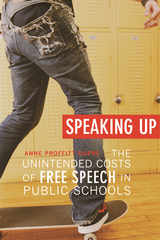
Just how much freedom of speech should high school students have? Does giving children and adolescents a far-reaching right of expression, without joining it to responsibility, ultimately result in an asylum that is run by its inmates?
Since the late 1960s, the United States Supreme Court has struggled to clarify the contours of constitutionally guaranteed freedom of speech rights for students. But as this thought-provoking book contends, these court opinions have pitted students—and their litigious parents—against schools while undermining the schools’ necessary disciplinary authority.
In a clear and lively style, sprinkled with wry humor, Anne Proffitt Dupre examines the way courts have wrestled with student expression in school. These fascinating cases deal with political protest, speech codes, student newspapers, book banning in school libraries, and the long-standing struggle over school prayer. Dupre also devotes an entire chapter to teacher speech rights. In the final chapter on the 2007 “Bong Hits 4 Jesus” case, she asks what many people probably wondered: when the Supreme Court gave teenagers the right to wear black armbands in school to protest the Vietnam War, just how far does this right go? Did the Court also give students who just wanted to provoke their principal the right to post signs advocating drug use?
Each chapter is full of insight into famous decisions and the inner workings of the courts. Speaking Up offers eye-opening history for students, teachers, lawyers, and parents seeking to understand how the law attempts to balance order and freedom in schools.


Conventional wisdom would have us believe that every immigrant to the United States “became American,” by choice and with deliberate speed. Yet, as Special Sorrows shows us, this is simply untrue. In this compelling revisionist study, Matthew Frye Jacobson reveals tenacious attachments to the Old World and explores the significance of homeland politics for Irish, Polish, and Jewish immigrants at the turn of the twentieth century.
Drawing on Yiddish, Polish, and English-language sources, Jacobson discovers the influence of nationalist ideologies in the overt political agendas of such ethnic associations as the Knights of Zion and the Polish Falcons, as well as in newspapers, vernacular theater, popular religion, poetry, fiction, and festivals, both religious and secular. In immigrant communities, he finds that nationalism was a powerful component of popular sensibility.
A captivating example of Jacobson’s thesis is immigrant reaction to American intervention in Cuba. Masculinist/militarist strains of nationalist culture met with the keen impulse to aid a subjugated people. The three national groups, rich with memories of their own subjugation, found an unlikely outlet in the Caribbean. But when the U.S. war for Cuban liberation was followed by a crusade for Philippine subjugation, immigrants faced a dilemma: some condemned the American empire rich in Old World parallels; others dismissed the Filipinos as racial “others” and embraced the glories of conquest. In effect, the crucible of American imperialism was vital to many immigrants’ Americanization, in the sense of passionate participation in national politics, pro or con.
This work answers the call of scholars to recover the full experience of these immigrants. It adds to the tapestry of America’s turn-of-the-century political culture and restores an essential transnational dimension to questions of ethnic identity and behavior.

This book gives a practical, applications-oriented account of the latest techniques for estimating and analyzing large, nonlinear macroeconomic models. Ray Fair demonstrates the application of these techniques in a detailed presentation of several actual models, including his United States model, his multicountry model, Sargent's classical macroeconomic model, autoregressive and vector autoregressive models, and a small (twelve equation) linear structural model. He devotes a good deal of attention to the difficult and often neglected problem of moving from theoretical to econometric models. In addition, he provides an extensive discussion of optimal control techniques and methods for estimating and analyzing rational expectations models.
A computer program that handles all the techniques in the book is available from the author, making it possible to use the techniques with little additional programming. The book presents the logic of this program. A smaller program for personal microcomputers for analysis of Fair's United States model is available from Urban Systems Research & Engineering, Inc. Anyone wanting to learn how to use large macroeconomic models, including researchers, graduate students, economic forecasters, and people in business and government both in the United States and abroad, will find this an essential guidebook.

This book is about the ritual world of a group of rural settlements in Shanxi province in pre-1949 North China. Temple festivals, with their giant processions, elaborate rituals, and operas, were the most important influence on the symbolic universe of ordinary villagers and demonstrate their remarkable capacity for religious and artistic creation. The great festivals described in this book were their supreme collective achievements and were carried out virtually without assistance from local officials or educated elites, clerical or lay.
Chinese culture was a performance culture, and ritual was the highest form of performance. Village ritual life everywhere in pre-revolutionary China was complex, conservative, and extraordinarily diverse. Festivals and their associated rituals and operas provided the emotional and intellectual materials out of which ordinary people constructed their ideas about the world of men and the realm of the gods. It is, David Johnson argues, impossible to form an adequate idea of traditional Chinese society without a thorough understanding of village ritual. Newly discovered liturgical manuscripts allow him to reconstruct North Chinese temple festivals in unprecedented detail and prove that they are sharply different from the Daoist- and Buddhist-based communal rituals of South China.
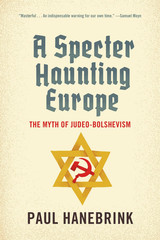
“Masterful…An indispensable warning for our own time.”
—Samuel Moyn
“Magisterial…Covers this dark history with insight and skill…A major intervention into our understanding of 20th-century Europe and the lessons we ought to take away from its history.”
—The Nation
For much of the last century, Europe was haunted by a threat of its own imagining: Judeo-Bolshevism. The belief that Communism was a Jewish plot to destroy the nations of Europe took hold during the Russian Revolution and quickly spread. During World War II, fears of a Judeo-Bolshevik conspiracy were fanned by the fascists and sparked a genocide. But the myth did not die with the end of Nazi Germany. A Specter Haunting Europe shows that this paranoid fantasy persists today in the toxic politics of revitalized right-wing nationalism.
“It is both salutary and depressing to be reminded of how enduring the trope of an exploitative global Jewish conspiracy against pure, humble, and selfless nationalists really is…A century after the end of the first world war, we have, it seems, learned very little.”
—Mark Mazower, Financial Times
“From the start, the fantasy held that an alien element—the Jews—aimed to subvert the cultural values and national identities of Western societies…The writers, politicians, and shills whose poisonous ideas he exhumes have many contemporary admirers.”
—Robert Legvold, Foreign Affairs


An adversarial advocate.
Aeschines, orator and statesman of Athens, 390 or 389–314 BC, became active in politics about 350. In 348 he was a member of a mission sent to the Peloponnese to stir up feeling against the growing power of King Philip of Macedon; but in 347, when part of a peacemaking embassy to Philip, was won over to sympathy with the king, and became a supporter of the peace policy of the Athenian statesman Eubulus. On a second embassy in 346 to ratify a peace Aeschines’ delaying tactics caused the famous orator Demosthenes and Timarchus to accuse him of treason, a charge that he successfully rebutted in the strong extant speech Against Timarchus. In 344–343, when Demosthenes accused him again in a speech, Aeschines replied in the fine extant speech having the same title On the False Embassy and was again acquitted. In 336, when Ctesiphon proposed that Demosthenes should be awarded a crown of gold for state service, Aeschines accused him of proposing something that would violate existing laws. At the trial Aeschines’ extant speech Against Ctesiphon was answered by Demosthenes in his masterpiece On the Crown. Aeschines, discredited, left Athens and set up a school of rhetoric at Rhodes. He died in Samos.
As examples of Greek oratory the speeches of Aeschines rank next to those of Demosthenes, and are important documents for the study of Athenian diplomacy and inner politics.
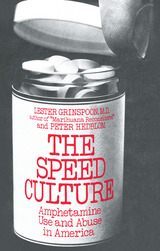
Speed kills—this fading bumper-sticker pun recalls the romance between the counterculture and amphetamines. But America's real involvement with "speed" began far earlier, and has endured in spite of the disasters of counterculture experimentation.
Amphetamines continue to be respectable drugs for all classes and all ages—even, increasingly, schoolchildren. Unlike alcohol, marihuana, opium, and cocaine—the other "recreational" drugs—amphetamine and its relatives have no natural source or long cultural tradition. They are entirely a product of modern laboratories. Available for less than forty years, during most of their history they have borne the stamp of official scientific and medical approval. Their deleterious effects—including severe habituation—have only slowly been recognized, and today there is still a sizable constituency favoring their use in so-called hyperkinetic children as well as in obese and depressed adults.
Lester Grinspoon, author of Marihuana Reconsidered, and Peter Hedblom have taken a hard look at the amphetamines and their effects on man. They explore the social forces that favor use of these substances: drug-company profits, medical convenience, and user acceptance. And they analyze evidence showing that amphetamines are dangerous and unnecessary drugs, perhaps even when prescribed by physicians. At a time when federal action against the illicit use of amphetamines is becoming more and more stringent, Grinspoon and Hedblom find that pressures to expand their "legitimate" use remain intense, however questionable the results. They illustrate explicit efforts to expand the use of such drugs through advertisements implying "that human life itself is a drug-deficiency disease." And they explore the more pervasive and subtler cultural pressures for conformity to an impossible ideal of physical and intellectual vigor, industriousness, and efficiency—an ideal that amphetamines once seemed to put in the reach of every man.

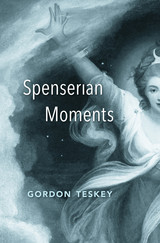
From the distinguished literary scholar Gordon Teskey comes an essay collection that restores Spenser to his rightful prominence in Renaissance studies, opening up the epic of The Faerie Queene as a grand, improvisatory project on human nature, and arguing—controversially—that it is Spenser, not Milton, who is the more important and relevant poet for the modern world.
There is more adventure in The Faerie Queene than in any other major English poem. But the epic of Arthurian knights, ladies, and dragons in Faerie Land, beloved by C. S. Lewis, is often regarded as quaint and obscure, and few critics have analyzed the poem as an experiment in open thinking. In this remarkable collection, the renowned literary scholar Gordon Teskey examines the masterwork with care and imagination, explaining the theory of allegory—now and in Edmund Spenser’s Elizabethan age—and illuminating the poem’s improvisatory moments as it embarks upon fairy tale, myth, and enchantment.
Milton, often considered the greatest English poet after Shakespeare, called Spenser his “original.” But Teskey argues that while Milton’s rigid ideology in Paradise Lost has failed the test of time, Spenser’s allegory invites engagement on contemporary terms ranging from power, gender, violence, and virtue ethics, to mobility, the posthuman, and the future of the planet. The Faerie Queene was unfinished when Spenser died in his forties. It is the brilliant work of a poet of youthful energy and philosophical vision who opens up new questions instead of answering old ones. The epic’s grand finale, “The Mutabilitie Cantos,” delivers a vision of human life as dizzyingly turbulent and constantly changing, leaving a future open to everything.

Edmund Spenser's art is intricate, intellectual, fanciful, and, finally, magnificent. Spenser is enshrined as one of the great English writers, and Book One of The Faerie Queene is regularly taught in colleges, not only in advanced courses but also in introductory surveys. Many teachers as well as students, however, find the poem baffling and know of no way to approach it except as an allegory whose several levels of meaning must be deciphered. Mark Rose shows that it is possible to read the poem as poetry—savoring the language, tracing Spenser's vision—without prior expertise in religion and philosophy, Renaissance iconography and mythology, or Tudor history. He offers a close reading of Book One, following the poem as it develops canto by canto.
Rather than expound the meaning, he attempts to draw the meaning out of the text while helping the reader respond freshly to the emotion, humor, grace, and humanity of the poem and conveying a sense of its richness and subtlety. Specialists will find many new insights in Spenser's Art, though the book is not addressed primarily to them; teachers who are not experts on Spenser will find it especially rewarding.

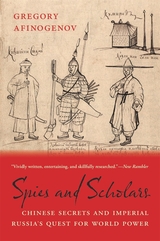
A Financial Times Best Book of the Year
The untold story of how Russian espionage in imperial China shaped the emergence of the Russian Empire as a global power.
From the seventeenth to the nineteenth century, the Russian Empire made concerted efforts to collect information about China. It bribed Chinese porcelain-makers to give up trade secrets, sent Buddhist monks to Mongolia on intelligence-gathering missions, and trained students at its Orthodox mission in Beijing to spy on their hosts. From diplomatic offices to guard posts on the Chinese frontier, Russians were producing knowledge everywhere, not only at elite institutions like the Academy of Sciences in St. Petersburg. But that information was secret, not destined for wide circulation.
Gregory Afinogenov distinguishes between the kinds of knowledge Russia sought over the years and argues that they changed with the shifting aims of the state and its perceived place in the world. In the seventeenth century, Russian bureaucrats were focused on China and the forbidding Siberian frontier. They relied more on spies, including Jesuit scholars stationed in China. In the early nineteenth century, the geopolitical challenge shifted to Europe: rivalry with Britain drove the Russians to stake their prestige on public-facing intellectual work, and knowledge of the East was embedded in the academy. None of these institutional configurations was especially effective in delivering strategic or commercial advantages. But various knowledge regimes did have their consequences. Knowledge filtered through Russian espionage and publication found its way to Europe, informing the encounter between China and Western empires.
Based on extensive archival research in Russia and beyond, Spies and Scholars breaks down long-accepted assumptions about the connection between knowledge regimes and imperial power and excavates an intellectual legacy largely neglected by historians.
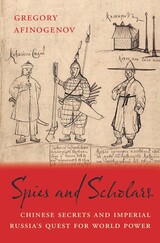
A Financial Times Book of the Year
Gold Medal in World History, Independent Publisher Book Awards
“Superb…At once a history of science, of empire, and of espionage, the book traces the rise of the Russian empire as a putative rival to Qing dynasty China in the Far East. Afinogenov has chosen a genuinely compelling cast of characters to populate this story of imperial intrigue.”—New Rambler
“The history of Sino-Russian relations appears in a much-altered light thanks to Gregory Afinogenov’s impressive new book…It is a little-known story, and [he] tells it beautifully.”—Tony Barber, Financial Times
“Reads like a detective novel…a tour de force that offers new information about the rise of empires and the globalization of the world.”—Journal of Jesuit Studies
Beginning in the seventeenth century, Russian officials made a concerted effort to collect information about the Qing dynasty in China. From diplomatic missions in the Forbidden City to remote outposts on the border, Russian spies and scholars collected trade secrets, recipes for porcelain, and gossip about the country and its leaders—but the information was secret, not destined for wide circulation.
Focused at first on the Siberian frontier, tsarist bureaucrats relied on spies, some of whom were Jesuit scholars stationed in China. When their attention shifted to Europe in the nineteenth century, they turned to more public-facing means to generate knowledge, including diplomatic and academic worlds, which would ultimately inform the broader encounter between China and Western empires. Peopled with a colorful cast of characters and based on extensive archival research in Russia and beyond, Spies and Scholars is a dramatic tale of covert machinations that breaks down long-accepted assumptions about the connection between knowledge and imperial power.

Spinal cord injury, or SCI, is frequently sudden and unexpected—through accident, disease, or violence, patients temporarily lose control of their bodies and, it seems, their lives. With rehabilitation, they can learn to navigate their world once more, retraining muscles and mind to compensate for paralyzed limbs and diminished strength. But as Dr. Michelle Alpert shows here, there is far more to recapturing full, independent lives than regaining movement. Central to long-term success is mending the family unit.
Combining Dr. Alpert’s clinical experience with patients’ own stories, Spinal Cord Injury and the Family is for individuals and their families who must climb back from injury: for the young quad couple, both quadriplegic, who wish to conceive and raise a child; for the paraplegic dad who wants to teach his daughter to drive; for the couple wondering how they can regain the sexual spark in their relationship.
The authors cover the causes of and prognosis for SCI through case studies, review common courses of rehabilitation, and answer the “what now?” questions—from daily routines to larger issues concerning sex, education and employment, childbearing, and parenting with SCI. Rich in clinical information and practical advice, the book shows how real patients and their families are living full lives after spinal cord injury.


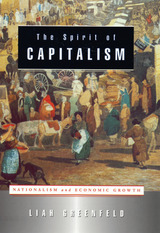
The Spirit of Capitalism answers a fundamental question of economics, a question neither economists nor economic historians have been able to answer: what are the reasons (rather than just the conditions) for sustained economic growth? Taking her title from Max Weber's famous study on the same subject, Liah Greenfeld focuses on the problem of motivation behind the epochal change in behavior, which from the sixteenth century on has reoriented one economy after another from subsistence to profit, transforming the nature of economic activity. A detailed analysis of the development of economic consciousness in England, the Netherlands, France, Germany, Japan, and the United States allows her to argue that the motivation, or "spirit," behind the modern, growth-oriented economy was not the liberation of the "rational economic actor," but rather nationalism. Nationalism committed masses of people to an endless race for national prestige and thus brought into being the phenomenon of economic competitiveness.
Nowhere has economic activity been further removed from the rational calculation of costs than in the United States, where the economy has come to be perceived as the end-all of political life and the determinant of all social progress. American "economic civilization" spurs the nation on to ever-greater economic achievement. But it turns Americans into workaholics, unsure of the purpose of their pursuits, and leads American statesmen to exaggerate the weight of economic concerns in foreign policy, often to the detriment of American political influence and the confusion of the rest of the world.

Lucian Pye, one of the most knowledgeable observers of China, unfolds in this book a deep psychological analysis of Chinese political culture. The dynamics of the Cultural Revolution, the behavior of the Red Guards, and the compulsions of Mao Tse-tung are among the important symptoms examined. But Pye goes behind large events, exploring the more enduring aspects of Chinese culture and the stable elements of the national psychology as they have been manifested in traditional, Republican, and Communist periods. He also scans several possible paths of future development. The emphasis is on the roles long played by authority, order, hierarchy, and emotional quietism in Chinese political culture as shaped by the Confucian tradition and the institution of filial piety, and the resulting confusions brought about by the displacements of these traditions in the face of political change and modernization.
In this new edition Pye adds a chapter on the basic tension between consensus and conflict in the operation of Chinese politics, illustrating the "spirit" in action, and another discussing the great gap that persists between the worlds of the political leadership and of society at large in post-Tiananmen China.





First published in 1902, and illustrated by Jacob Epstein, this evocation of the spiritual and cultural life of Yiddish New York remains fresh and relevant, and an invaluable commentary on one aspect of the formation of modern America.
To an extent unequaled by any outsider before him, Hutchins Hapgood, a descendant of generations of New England Yankees, succeeded in penetrating the inner life of an American immigrant community. Hapgood did not set out to reform and cleanse the ghetto. His aim was to understand and interpret it, to find and know its poets, scholars, dramatists, actors, and artists, as well as its merchants and businessmen. He presents real people, individually identified and described, working out their destiny as part of a vital Jewish world. The sensibility and intentions of this book, as the editor points out, “anticipated a period of unexampled American artistic and intellectual gusto and creativity.” Moses Rischin’s discerning and affectionate introduction places Hapgood’s neglected classic squarely in the mainstream of American cultural development.
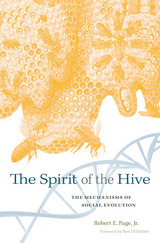
Charles Darwin struggled to explain how forty thousand bees working in the dark, seemingly by instinct alone, could organize themselves to construct something as perfect as a honey comb. How do bees accomplish such incredible tasks? Synthesizing the findings of decades of experiments, The Spirit of the Hive presents a comprehensive picture of the genetic and physiological mechanisms underlying the division of labor in honey bee colonies and explains how bees’ complex social behavior has evolved over millions of years.
Robert Page, one of the foremost honey bee geneticists in the world, sheds light on how the coordinated activity of hives arises naturally when worker bees respond to stimuli in their environment. The actions they take in turn alter the environment and so change the stimuli for their nestmates. For example, a bee detecting ample stores of pollen in the hive is inhibited from foraging for more, whereas detecting the presence of hungry young larvae will stimulate pollen gathering. Division of labor, Page shows, is an inevitable product of group living, because individual bees vary genetically and physiologically in their sensitivities to stimuli and have different probabilities of encountering and responding to them.
A fascinating window into self-organizing regulatory networks of honey bees, The Spirit of the Hive applies genomics, evolution, and behavior to elucidate the details of social structure and advance our understanding of complex adaptive systems in nature.
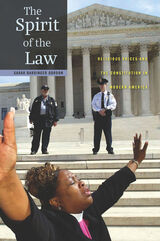
A new constitutional world burst into American life in the mid-twentieth century. For the first time, the national constitution's religion clauses were extended by the United States Supreme Court to all state and local governments. As energized religious individuals and groups probed the new boundaries between religion and government and claimed their sacred rights in court, a complex and evolving landscape of religion and law emerged.
Sarah Gordon tells the stories of passionate believers who turned to the law and the courts to facilitate a dazzling diversity of spiritual practice. Legal decisions revealed the exquisite difficulty of gauging where religion ends and government begins. Controversies over school prayer, public funding, religion in prison, same-sex marriage, and secular rituals roiled long-standing assumptions about religion in public life. The range and depth of such conflicts were remarkable—and ubiquitous.
Telling the story from the ground up, Gordon recovers religious practices and traditions that have generated compelling claims while transforming the law of religion. From isolated schoolchildren to outraged housewives and defiant prisoners, believers invoked legal protection while courts struggled to produce stable constitutional standards. In a field dominated by controversy, the vital connection between popular and legal constitutional understandings has sometimes been obscured. The Spirit of the Law explores this tumultuous constitutional world, demonstrating how religion and law have often seemed irreconcilable, even as they became deeply entwined in modern America.
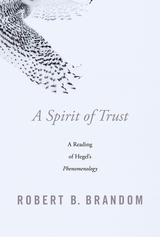
Forty years in the making, this long-awaited reinterpretation of Hegel’s The Phenomenology of Spirit is a landmark contribution to philosophy by one of the world’s best-known and most influential philosophers.
In this much-anticipated work, Robert Brandom presents a completely new retelling of the romantic rationalist adventure of ideas that is Hegel’s classic The Phenomenology of Spirit. Connecting analytic, continental, and historical traditions, Brandom shows how dominant modes of thought in contemporary philosophy are challenged by Hegel.
A Spirit of Trust is about the massive historical shift in the life of humankind that constitutes the advent of modernity. In his Critiques, Kant talks about the distinction between what things are in themselves and how they appear to us; Hegel sees Kant’s distinction as making explicit what separates the ancient and modern worlds. In the ancient world, normative statuses—judgments of what ought to be—were taken to state objective facts. In the modern world, these judgments are taken to be determined by attitudes—subjective stances. Hegel supports a view combining both of those approaches, which Brandom calls “objective idealism”: there is an objective reality, but we cannot make sense of it without first making sense of how we think about it.
According to Hegel’s approach, we become agents only when taken as such by other agents. This means that normative statuses such as commitment, responsibility, and authority are instituted by social practices of reciprocal recognition. Brandom argues that when our self-conscious recognitive attitudes take the radical form of magnanimity and trust that Hegel describes, we can overcome a troubled modernity and enter a new age of spirit.

This book represents the first continuous history of Sufism in Palestine. Covering the period between the rise of Islam and the spread of Ottoman rule and drawing on vast biographical material and complementary evidence, the book describes the social trajectory that Sufism followed. The narrative centers on the process by which ascetics, mystics, and holy figures living in medieval Palestine and collectively labeled “Sufis,” disseminated their traditions, formed communities, and helped shape an Islamic society and space. The work makes an original contribution to the study of the diffusion of Islam’s religious traditions and the formation of communities of believers in medieval Palestine, as well as the Islamization of Palestinian landscape and the spread of popular religiosity in this area.
The study of the area-specific is placed within the broader context of the history of Sufism, and the book is laced with observations about the historical-social dimensions of Islamic mysticism in general. Central to its subject matters are the diffusion of Sufi traditions, the extension of the social horizons of Sufism, and the emergence of institutions and public spaces around the Sufi friend of God. As such, the book is of interest to historians in the fields of Sufism, Islam, and the Near East.

As a study of the greatest middle class party of Imperial Germany, The Splintered Party is inevitably, in its broadest aspect, an inquiry into the weaknesses of liberalism in the Empire of Bismarck and Wilhelm II. How did the National Liberals, the dominant force in the Reichstag of the 1870s, become by 1914 a spent and divided power? Dan White explores this question from a new perspective, emphasizing regional circumstances as primary agents of the party’s decline. The resulting portrait underscores the paradox of the National Liberals: a party with strength in all areas of the Empire, a rarity before 1914, yet a party whose impact was undermined by divisions among its regional branches.
In The Splintered Party the former Grand Duchy of Hessen serves as a testing ground where the regional foundations of National Liberalism can be exposed. As Professor White points out, the party’s reversals on the Imperial plane after 1878—rejection by Bismarck, electoral defeats, internal splits—not only ended its early primacy in German affairs but also shifted political initiative from Berlin and the Reichstag delegation to the National Liberal branches in the states and provinces, which had maintained unity, power, and alliances with local government in spite of the upheaval above them. The consequences of this change become visible through close examination of the political and social structure in Hessen. On the regional level a liberalism based on the claim to majority representation by the notables (Honoratioren) of bourgeois society, a creed no longer plausible in national politics, remained defensible. Through the Heidelberg Declaration of 1884 the National Liberals of the German Southwest attempted to buttress this approach with an economic and social platform and, simultaneously, to make it the impulse of the national party’s revival. But they succeeded only in deferring National Liberalism’s adjustment to democratic politics and in subordinating their movement to the clash of regional and constituency interests. The result was a chronically splintered party.
Against the backdrop of this main theme, White delineates several additional features of the changing political and social scene in Imperial Germany—the local power of the notables, Bismarck’s skills as a political manager, the character of agrarian discontent and rural anti-Semitism, the steady advance of socialism. The uniquely German element in National Liberalism’s failure is assessed in a concluding comparison with the development of liberal politics in Britain and Italy.
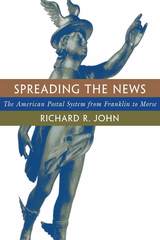
In the seven decades from its establishment in 1775 to the commercialization of the electric telegraph in 1844, the American postal system spurred a communications revolution no less far-reaching than the subsequent revolutions associated with the telegraph, telephone, and computer. This book tells the story of that revolution and the challenge it posed for American business, politics, and cultural life.
During the early republic, the postal system was widely hailed as one of the most important institutions of the day. No other institution had the capacity to transmit such a large volume of information on a regular basis over such an enormous geographical expanse. The stagecoaches and postriders who conveyed the mail were virtually synonymous with speed.
In the United States, the unimpeded transmission of information has long been hailed as a positive good. In few other countries has informational mobility been such a cherished ideal. Richard John shows how postal policy can help explain this state of affairs. He discusses its influence on the development of such information-intensive institutions as the national market, the voluntary association, and the mass party. He traces its consequences for ordinary Americans, including women, blacks, and the poor. In a broader sense, he shows how the postal system worked to create a national society out of a loose union of confederated states. This exploration of the role of the postal system in American public life provides a fresh perspective not only on an important but neglected chapter in American history, but also on the origins of some of the most distinctive features of American life today.

This new edition of Fundamentals of Radiology brings up to date the consummate, classic work by Lucy Frank Squire and Robert A. Novelline that has introduced generations of medical students to radiology.
The standard introductory text for more than thirty years, Fundamentals of Radiology is a model of clarity and comprehensiveness. Robert Novelline continues that tradition by thoroughly updating and expanding this edition to reflect the latest types and uses of imaging techniques. Complementing the text are many superb reproductions of plain film, computed tomography, magnetic-resonance, and ultrasound images--hundreds of them new to this edition. In addition, Novelline has added five important chapters. A new chapter near the beginning of the book provides an atlas of drawings and images that allows the reader to review normal plain film and CT anatomy. Another new chapter is devoted to vascular imaging, including CT angiography, MR angiography, and vascular ultrasound, especially full-color Doppler ultrasound images. The chapter on interventional radiology covers therapeutic procedures performed by radiologists, such as angioplasty, embolization, and percutaneous biopsy. To address the different medical conditions of males, females, and children, another new chapter examines the imaging of obstetrical, gynecological, testicular, prostate, and urethral disorders, and considers a variety of childhood ailments and problems, including child abuse. Finally, a new chapter on TB and AIDS shows how radiology can track the course of a single disease over time and trace the depredations of a multisystem disease.

Medical students preparing for a career in clinical practice must become familiar with a wide range of diagnostic imaging techniques and image-guided interventions. They must learn to identify the indications for radiological examination and recognize the role each procedure plays in the workup, diagnosis, and therapeutic management of patients. That is why Squire’s Fundamentals of Radiology has been such an important, long-standing resource for medical students, physicians, and other professionals at all stages of their careers. It teaches essential topics in the radiology curriculum and features hundreds of illustrative cases clinicians can turn to again and again in practice.
In this long-awaited seventh edition, Robert Novelline provides more than 600 new high-resolution images representing the current breadth of radiological procedures: conventional x-rays, ultrasound, computed tomography (CT), magnetic resonance imaging (MRI), angiography, radioisotope scanning, positron emission tomography (PET), and molecular imaging. This edition’s expanded coverage addresses dual energy CT, breast tomosynthesis, PET-MR scanning, and tractography brain imaging, along with best practices for managing patient experiences during and after examination. All new images were produced at a major teaching hospital using state-of-the-art imaging technologies.
Squire’s Fundamentals of Radiology is designed to be read cover to cover by students, with concepts, principles, and methods progressing in a logical, cumulative manner. It also serves as an invaluable tool for teachers and an indispensable reference for seasoned practitioners. Written by a radiologist who has trained thousands of medical students and residents, this textbook is the clear choice for excelling in the general practice of radiology.


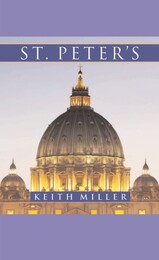
Built by the decree of Constantine, rebuilt by some of the most distinguished architects in Renaissance Italy, emulated by Hitler’s architect in his vision for Germania, immortalized on film by Fellini, and fictionalized by a modern American bestseller, St. Peter’s is the most easily recognizable church in the world. This book is a cultural history of one of the most significant structures in the West. It bears the imprint of Bramante, Raphael, Michelangelo, Bernini, and Canova. For Grand Tourists of the eighteenth century, St. Peter’s exemplified the sublime. It continues to fascinate visitors today and appears globally as a familiar symbol of the papacy and of the Catholic Church itself.
The church was first built in the fourth century on what is thought to be the tomb of Peter—the rock upon which Christ decreed his church shall be built. After twelve hundred years, the church was largely demolished and rebuilt in the sixteenth century when it came to acquire its present-day form. St. Peter’s awes the visitor by its gigantic proportions, creating a city within itself. It is the mother church, the womb from which churches around the world have taken inspiration. This book covers the social, political, and architectural history of the church from the fourth century to the present. From the threshold, to the subterranean Roman necropolis, to the dizzying heights of the dome, this book provides rare perspectives and contexts for understanding the shape and significance of the most illustrious church in the world.

This sparkling account of the great age of Whiggery during the reigns of George I and II is distinguished by its attention to social history. The author deftly explains how the political transformation which brought an end to the “rage of party” under Queen Anne and ushered in the “strife of faction” under the Hanoverians was related to social and economic conditions. This major political change brought stability to England and—by important, though incremental shifts in mobility, religion, agriculture, industry, and literacy—slowly transformed English society.
W. A. Speck argues that in 1714 England was ruled by rival elites called Tory and Whig and that by 1760 they had fused to form a ruling class. This union became possible as divisive issues faded and economic and political interests were shared. Whiggery itself, however, split apart for lesser reasons. “Country” Whigs were restorationists on moral and religious grounds while “Court” Whigs—neither Saints, nor Spartans, nor Reformers—created the mechanisms to realize the promise of the Glorious Revolution of 1689: mixed monarchy, property and liberty, and Protestantism.
Stability and Strife is the most up-to-date book in English eighteenth-century history in its methods—the use of social science data and literary sources—and in its sophisticated topical and narrative approaches to this fascinating era.

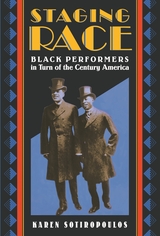
Staging Race casts a spotlight on the generation of black artists who came of age between 1890 and World War I in an era of Jim Crow segregation and heightened racial tensions. As public entertainment expanded through vaudeville, minstrel shows, and world's fairs, black performers, like the stage duo of Bert Williams and George Walker, used the conventions of blackface to appear in front of, and appeal to, white audiences. At the same time, they communicated a leitmotif of black cultural humor and political comment to the black audiences segregated in balcony seats. With ingenuity and innovation, they enacted racial stereotypes onstage while hoping to unmask the fictions that upheld them offstage.
Drawing extensively on black newspapers and commentary of the period, Karen Sotiropoulos shows how black performers and composers participated in a politically charged debate about the role of the expressive arts in the struggle for equality. Despite the racial violence, disenfranchisement, and the segregation of virtually all public space, they used America's new businesses of popular entertainment as vehicles for their own creativity and as spheres for political engagement.
The story of how African Americans entered the stage door and transformed popular culture is a largely untold story. Although ultimately unable to erase racist stereotypes, these pioneering artists brought black music and dance into America's mainstream and helped to spur racial advancement.
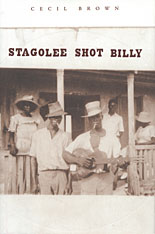
Although his story has been told countless times--by performers from Ma Rainey, Cab Calloway, and the Isley Brothers to Ike and Tina Turner, James Brown, and Taj Mahal--no one seems to know who Stagolee really is. Stack Lee? Stagger Lee? He has gone by all these names in the ballad that has kept his exploits before us for over a century. Delving into a subculture of St. Louis known as "Deep Morgan," Cecil Brown emerges with the facts behind the legend to unfold the mystery of Stack Lee and the incident that led to murder in 1895.
How the legend grew is a story in itself, and Brown tracks it through variants of the song "Stack Lee"--from early ragtime versions of the '20s, to Mississippi John Hurt's rendition in the '30s, to John Lomax's 1940s prison versions, to interpretations by Lloyd Price, James Brown, and Wilson Pickett, right up to the hip-hop renderings of the '90s. Drawing upon the works of James Baldwin, Richard Wright, and Ralph Ellison, Brown describes the powerful influence of a legend bigger than literature, one whose transformation reflects changing views of black musical forms, and African Americans' altered attitudes toward black male identity, gender, and police brutality. This book takes you to the heart of America, into the soul and circumstances of a legend that has conveyed a painful and elusive truth about our culture.

Overthrowing the conventional image of Stalin as an uneducated political administrator inexplicably transformed into a pathological killer, Robert Service reveals a more complex and fascinating story behind this notorious twentieth-century figure. Drawing on unexplored archives and personal testimonies gathered from across Russia and Georgia, this is the first full-scale biography of the Soviet dictator in twenty years.
Service describes in unprecedented detail the first half of Stalin's life--his childhood in Georgia as the son of a violent, drunkard father and a devoted mother; his education and religious training; and his political activity as a young revolutionary. No mere messenger for Lenin, Stalin was a prominent activist long before the Russian Revolution. Equally compelling is the depiction of Stalin as Soviet leader. Service recasts the image of Stalin as unimpeded despot; his control was not limitless. And his conviction that enemies surrounded him was not entirely unfounded.
Stalin was not just a vengeful dictator but also a man fascinated by ideas and a voracious reader of Marxist doctrine and Russian and Georgian literature as well as an internationalist committed to seeing Russia assume a powerful role on the world stage. In examining the multidimensional legacy of Stalin, Service helps explain why later would-be reformers--such as Khrushchev and Gorbachev--found the Stalinist legacy surprisingly hard to dislodge.
Rather than diminishing the horrors of Stalinism, this is an account all the more disturbing for presenting a believable human portrait. Service's lifetime engagement with Soviet Russia has resulted in the most comprehensive and compelling portrayal of Stalin to date.
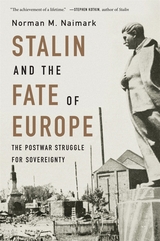
Winner of the Norris and Carol Hundley Award
Winner of the U.S.–Russia Relations Book Prize
A Financial Times Best History Book of the Year
The Cold War division of Europe was not inevitable—the acclaimed author of Stalin’s Genocides shows how postwar Europeans fought to determine their own destinies.
Was the division of Europe after World War II inevitable? In this powerful reassessment of the postwar order in Europe, Norman Naimark suggests that Joseph Stalin was far more open to a settlement on the continent than we have thought. Through revealing case studies from Poland and Yugoslavia to Denmark and Albania, Naimark recasts the early Cold War by focusing on Europeans’ fight to determine their future.
As nations devastated by war began rebuilding, Soviet intentions loomed large. Stalin’s armies controlled most of the eastern half of the continent, and in France and Italy, communist parties were serious political forces. Yet Naimark reveals a surprisingly flexible Stalin, who initially had no intention of dividing Europe. During a window of opportunity from 1945 to 1948, leaders across the political spectrum, including Juho Kusti Paasikivi of Finland, Wladyslaw Gomulka of Poland, and Karl Renner of Austria, pushed back against outside pressures. For some, this meant struggling against Soviet dominance. For others, it meant enlisting the Americans to support their aims.
The first frost of Cold War could be felt in the tense patrolling of zones of occupation in Germany, but not until 1948, with the coup in Czechoslovakia and the Berlin Blockade, did the familiar polarization set in. The split did not become irreversible until the formal division of Germany and establishment of NATO in 1949. In illuminating how European leaders deftly managed national interests in the face of dominating powers, Stalin and the Fate of Europe reveals the real potential of an alternative trajectory for the continent.
READERS
Browse our collection.
PUBLISHERS
See BiblioVault's publisher services.
STUDENT SERVICES
Files for college accessibility offices.
UChicago Accessibility Resources
home | accessibility | search | about | contact us
BiblioVault ® 2001 - 2024
The University of Chicago Press









